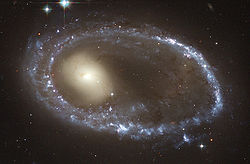AM 0644-741
| AM 0644-741 | |
|---|---|
| Photo from the Hubble Space Telescope | |
|
Observation dates equinox : J2000.0 , epoch : J2000.0 |
|
| Constellation | Volans |
| Right ascension | 6 h 43 m 6.1 s |
| declination | −74 ° 13 ′ 35 ″ |
| Appearance | |
| Apparent brightness (B-band) | approx. 13.8 mag |
| Angular expansion | 1 ′, 7 |
| Physical data | |
| Heliocentric radial velocity | (6604 ± 26) km / s |
| distance | approx. 300 million ly |
| diameter | approx. 150,000 ly |
| Designations and catalog entries | |
| AM 0644-741 • ESO 34-11 • VV 785 • IRAS 06443-7411 • SGC 064425-7411.1 | |
AM 0644-741 , also called Lindsay-Shapley-Ring , is a ring galaxy with a lenticular galaxy in the center. Its distance is around 300 million light years and it is located in the constellation of Volans . The ring is about 150,000 light years in diameter and the lenticular core was previously the center of a normal spiral galaxy .
Origin and nature of the ring
The ring of AM 0644-741 was created by a collision with another galaxy, which triggered a gravitational disturbance. Such ring galaxies are created when a galaxy coming from outside moves through the disk of a galaxy. The passage creates a shock wave that pushes gas and dust outward. When the shock ring moves outwards, clouds of gas and dust contract due to gravity and create new stars within.
The ring is a turbulent star formation region that is mainly home to young, hot blue stars . It will continue to expand for the next 300 million years and then slowly dissolve.
Fluorescent hydrogen regions
The pink areas (visible in the picture as small pink dots) are thin clouds of hot hydrogen gas. The hot young stars irradiate this gas with intense ultraviolet light, causing it to fluoresce .
Web links
- The Lure of the Rings (English) - News release of the Hubble-Site / NASA-Newsdesk for AM 0644-741
- AM 0644-741 (English) - AM 0644-741 in the extragalactic database of NASA / IPAC
